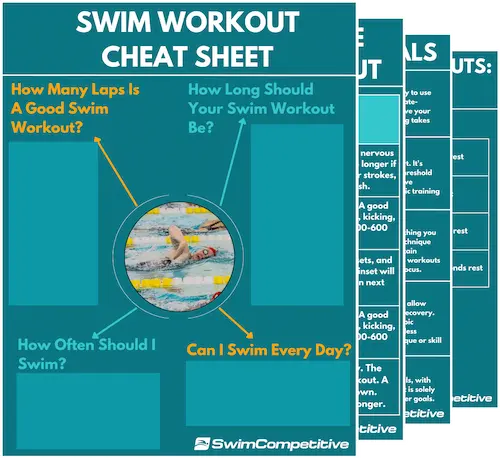Butterfly is one of the hardest and most energy-consuming strokes in swimming with many swimmers being terrified of swimming it. Swimming a good and fast butterfly requires extreme strength, endurance, and power- and can get you quite tired, to say the least.
You might also find it interesting to know that butterfly is actually the fastest swimming stroke when you reach your peak speed, but since tempo drops significantly during the recovery phase and due to the high energy demand of the stroke it is actually slightly slower than freestyle over the course of a race.
So with that said, you are probably wondering how to swim butterfly without getting tired? Or is it even possible at all?
In short- yes it is possible to swim butterfly without getting tired, although that shouldn’t be your main goal. The key to swimming butterfly without getting tired is to focus on staying relaxed, breathing properly, using a strong kick, and perfecting your swimming technique in the water.
Keep in mind, the point of competitive swimming isn’t to be able to swim without getting tired, but rather to swim as fast as possible and ultimately win your race. Like my coach has always told us during a hard training session- “If you are looking for a sport that is easy, go play chess”.
And yes, even in a race you’ll be able to swim a certain distance of butterfly without getting tired, but if you want to be able to swim as fast as you can, you will inevitably get tired as you near the end of the race and push your body to the limit. How quickly you become tired depends on the race, in a 50 the end will come much sooner than in a 200 butterfly.
So with that cleared up, the main way to swim butterfly without getting tired is to reduce the amount of energy used when swimming. This can be done by reducing resistance as must as possible, using the natural rhythm and momentum of the stroke to your advantage, and keeping your muscles relaxed.
In the grand scheme of things, this isn’t the only benefit of improving your technique and body position. When you have more energy available you will be able to direct that energy into swimming faster, ultimately smashing your best times and winning your butterfly races.
5 Tips for Swimming Butterfly Without Getting Tired
Here are a few tips for swimming butterfly without getting tired-
- Master your butterfly swimming technique to reduce resistance and conserve energy.
- Use a strong kick to set your rhythm.
- Take deep and controlled breaths to fuel muscles with oxygen and to keep relaxed.
- Swim at a controlled pace with a race plan in mind.
- Train butterfly more, the fitter you are the easier it becomes.
- Use cross-training to strengthen muscles involved.
1. Efficient Butterfly Swimming: Body Position and Technique
Butterfly Body Position
Proper body position is by far one of the most important factors when it comes to reducing resistance in the water and improving your butterfly swimming efficiency.
Body position is the most basic aspect of mastering the swimming technique in any given stroke. If you can’t swim with a good body position you won’t be able to ever fully master the other aspects of the butterfly technique and you’ll never be able to swim butterfly without getting tired.
So what does good butterfly body position look like?
The first step in improving your body position is to place your body in a streamlined position. Next, you want to tuck your head in towards your chest.
After that, you need to focus on the lower body, remember the main point of body position is to aim to swim on top of the water, and to be as buoyant as possible.
Focus on pushing your hips slightly out and upwards, your legs will automatically rise higher in the water when you do this. Keep your toes pointed to ensure that your feet don’t create drag at the back end of your stroke.
After all of this, your body should be in an almost perfectly horizontal line as you swim. That is what you’re aiming for.
Practice setting up your body position in your butterfly and other strokes every day, in the beginning, it might be hard and frustrating, but it becomes easier as you get more comfortable with the feeling and position in the water.
Here’s a little video for a more visual explanation-
Common Body Position Mistakes
I want to quickly discuss a few common mistakes that may occur due to a misunderstanding of the body position in the butterfly stroke.
The first of which is kicking on top of the water, due to the swimmer aiming to swim as high as possible in the water to reduce resistance they might forget that you still need to actually kick under the water as much as possible.
Kicking on top of the water won’t help to build speed and it will be a complete waste of energy.
The second error is when a swimmer starts moving their head too much due to the different positioning. It is still important to remember to keep the head still and controlled in a neutral position when swimming butterfly. Many swimmers may look directly forward, this is wrong, you should aim to look down or just in front of you on the floor.
The Butterfly Arm Stroke
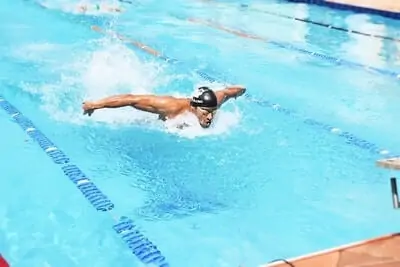
Next, we will take a look at the butterfly arm mechanics which can be broken down into three main phases, namely the catch, the pull, and the recovery
The stroke begins with the catching motion which is going to allow you to get a good grip in the water, allowing for a strong pull and good propulsion. Your hands will enter the water starting with the fingertips, after that, they’ll move down and outwards at shoulder width with the palms facing out, where they will then proceed to form a Y shape.
Keep in mind some swimmers like to take a wider entry and some a more narrow entry. It depends on what’s most comfortable for you. Once you are in the Y or overhead position your elbows will bend in until your fingertips are facing down to the floor and this is where the next part of the arm stroke will start, namely the pull.
The pulling movement is relatively short in comparison to the catch and recovery motion. However, it is one of the most critical parts of building speed in the water. As soon as the catching phase ends, you want to increase power and speed in the arms and create a powerful pulling motion that will shoot your arms out of the water into the recovery phase.
The push ends and the recovery starts when the hands exit the water. The recovery phase is very important if you want to conserve energy in the water and swim butterfly without getting (too) tired.
During the recovery phase, the arms will move back over the water so that your hands can re-enter the water to start the catching phase of the next stroke again, additionally, you will breathe during this motion, but try to keep it short.
a Common mistake many swimmers make in the arm movement of the butterfly technique is that they don’t use enough power and energy on the pulling motion.
This can quickly become a problem because now you need to use more power and energy during the recovery phase to help pull the arms over the body, whereas if they had done a proper push they wouldn’t have to use this energy.
That said, it’s important to realize that this entire motion will happen very quickly. It’s best to slow down your tempo and focus on doing everything right when you are working on your technique.
The Butterfly Kick
The kicking motion plays a big role in building speed and helping the swimmer to move the shoulders and arms out and over the water effectively. It also sets the rhythm for your entire stroke and is without a doubt one of the single most important factors along with body position when it comes to swimming butterfly.
The rules of swimming allow butterfly swimmers to use as many butterfly kicks as they want to during each arm cycle. However, the most efficient way to swim is by using two kicks per arm cycle.
These two kicks can also be broken down into two different phases- The first phase is the explosive kick and the second is the “recovery kick”.
The explosive kick is the first kick in your butterfly stroke and goes along with the pushing phase of the arms. This kick should be a smaller and strong kick. It will help your arms and shoulders to exit the water and enter the recovery phase.
As soon as the recovery phase starts you can start your “recovery kick”. This kick is a bigger kick and is meant to help push your hips out of the water to ensure you maintain that high body position. Keep in mind this kick should still use the same amount of power as the first, it’s just spread out over a bigger range of motion.
As you would have noticed these kicks happen very fast and are actually quite close to each other when swimming, therefore I once again recommend you to slow down your tempo when working on your butterfly swimming technique.
So with all that said, keep in mind there are many more little details that go into butterfly swimming technique- from head position during the breathing phase, hand entry, and much more. This is just an outline of the most important aspects that you should work on mastering first.
Did you know tech suits can improve swimming performance? Consider checking out my article on the best tech suits for butterfly swimmers or if you are unsure read my article- do tech suits make a difference?
Do You Want to Make Every Lap Count?
Stop wasting your time in the pool feeling lost and doing directionless swim workouts, and start training effectively! Our ebook contains 97 structured and goal-orientated swim workouts to help you become a better, faster, and fitter swimmer. Whether you’re a complete beginner or a seasoned pro, there are a multitude of workouts for every type of swimmer.
2. Proper Breathing Is Key
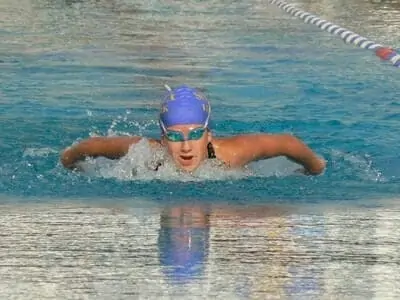
When we are swimming the cells in your muscles will respire more than they do when your body is at rest.
Your heart rate will also increase, the function of this is to pump more oxygen into your blood so that your muscles are able to produce something known as ATP (a form of energy).
Respiration combined with an increased heart rate will also help to remove carbon dioxide and other toxins from your blood faster.
However, since we are swimming, our oxygen supply is limited. Because of this, it is important to optimize our breathing as much as possible. This will allow us to consume the maximum amount of oxygen with every breath we take.
You can optimize your breathing by blowing out as much air as you can in between strokes. This will help to empty your lungs so that you can quickly take a breath and fill your lungs with new air.
If you are keeping your head down for more than one stroke it might be a good idea to hold onto your current air supply for a bit longer. You should only start breathing out a stroke or two before you are going to take a breath.
Pro Tip: Keep your breathing relaxed, this really helps. I use this breathing technique mostly in my 200 butterfly and during the first 50 of my 100 butterfly. This technique can help to significantly calm yourself down and swim a more relaxed stroke while maintaining speed.
Relaxed doesn’t necessarily mean slower, but it significantly reduces the amount of energy used. For this, I recommend taking deep, slow, and controlled breaths as you swim. Make sure to exhale completely and inhale nice and deeply when taking a breath.
You might also want to consider checking out my article on the best breathing exercises for swimmers.
3. Swim with a Controlled Pace with a Race Plan in Mind
There is a term in competitive swimming called- controlled speed. The meaning of it is to swim comfortably and relaxed, whilst maintaining a high tempo. Using this technique you can swim near your best times, with far less effort.
For example let’s say your 50m fly time is a 27.83, well using controlled speed you can easily swim a 28.10-28.20 without using nearly as much energy. Although I don’t really recommend using controlled speed on a 50, it is best suited to longer swimming events like 200 butterfly and 100 butterfly occasionally.
This will allow you to swim at a fast but relaxed pace the first 150 of your 200 and then use the rest of your energy to sprint to the finish line in the last 50.
When you combine this technique with a good race plan, you will be able to significantly reduce the amount of energy used during some of your laps. You will then use the saved energy in the last 50 or 100 to build as much speed as possible and finish strongly.
To best apply this swimming technique you want to make sure that your technique is good as we discussed earlier, make sure you are using all of your body parts to push and pull the water in order to create propulsion, but keep everything relaxed and don’t tense up, it should feel as if you are just sliding through the water.
Related: How To Swim The 100 Fly- Full Race Plan.
4. Train Butterfly More- the Fitter You Are, the Easier It Becomes
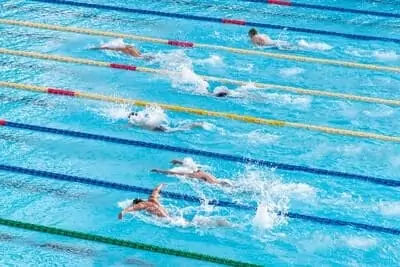
The last tip I have for you is to simply swim more butterfly. This might sound counterproductive and might not be what you want to hear, especially for those swimmers who are just swimming it because your coach told you to.
Burn a little more, take the pain a little bit more. Eventually, it will start to become much easier.
Not only will your body become stronger and adapt to the physical requirements of butterfly swimming, but you will also have much more time to work on perfecting your technique and body position in the water.
Eventually, a set of 10x200s butterfly will become easy. You will be able to swim faster and finally master the grueling art of butterfly swimming.
Another benefit of doing this is that you are naturally going to improve your other strokes as well by involving a slightly different set of muscle groups and increasing your overall conditioning since your body isn’t used to swimming butterfly as much.
Related: 10 awesome drills for faster butterfly swimming
5. Incorporate Cross-Training to Improve Your Butterfly Efficiency
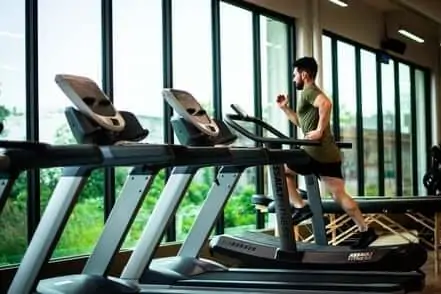
Cross-training is one of the most effective ways to become a better and faster swimmer and to improve your overall stroke efficiency in the water. It will help you to strengthen critical muscle groups used in butterfly swimming and other strokes and will ultimately help you to swim faster for longer, meaning you won’t get tired as quickly.
There are many variations of cross-training that swimmers can incorporate, the most popular is probably dryland training. Other good methods include weight training, running, cycling, plyometric training, gymnastics, and so on.
In this article, I won’t go into too much depth about this, but consider checking out some of my other dryland and cross-training articles for some good ideas-
- Best core exercises for butterfly swimmers.
- Best dryland exercises for butterfly swimmers.
- Strength exercises for swimmers.
- Resistance band exercises for swimmers.
Use These Tips to Swim Butterfly Without Getting Tired
I hope this helps you to improve your butterfly and that you will be able to swim with less effort and possibly not even get tired when swimming butterfly (wink, wink- probably not, though).
Remember if you are absolutely dead after a race that is excellent, that is what you want. You never want to feel like you could have given more because that means you could have. You want to know that you have done your best and that your best was enough.
For those of you who are here because you are scared after your coach assigned you a 200 butterfly for next weekend’s meet, don’t worry! Just follow these tips, utilize controlled speed, and give it your everything that last 50. Don’t hold back, and good luck!
